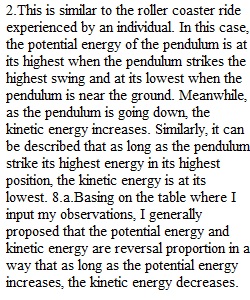


Q Name: Date: June 27, 2017 Core Class: 1 2 3 4 Lab: Relationship Between Kinetic and Potential Energy Go to the following website http://glencoe.mcgraw-hill.com/sites/dl/free/0078693896/280410/PS05.html, complete the lab procedures, and answer the questions that follow. Purpose: *To distinguish between kinetic and potential energy *To recognize that energy can change from one form to other forms with NO loss of total energy Gathering of Information: Energy is the ability to cause change. Energy exists in many forms. Some of these forms include radiant, electrical, chemical, thermal, and nuclear energy. Kinetic energy is energy in the form of motion, such as in a bouncing ball. Potential energy is stored energy. The amount of potential energy an object has depends on its position or condition. In the Virtual Lab, you will learn about the relationship between potential energy and kinetic energy by swinging a pendulum and observing bar and wave graphs as they illustrate its energy. For the purposes of this activity, assume that there is NO friction of air resistance. Hypothesis: ---------- Materials: Computers Procedures: 1. Click the Video button. Watch the video about potential and kinetic energy. Observe the point at which the clock pendulums and the swings are at their highest and lowest kinetic and potential energy. 2. When do you think the clock pendulums and the swings will be at their highest and lowest kinetic and potential energy? Why? 3. Click the weight at the end of the pendulum arm and drag it to the desired height on the protractor. 4. Click the Swing button. 5. Observe what happens to the bar and wave graphs as the pendulum swings. Record the data in Data Table 1. The arrow on the pendulum always points in the direction of its motion. Adapted from http://glencoe.mcgraw-hill.com/sites/dl/free/0078693896/280410/PS05.html 6. Click the Pause button to stop the pendulum at different points in its swing. Observe the potential and kinetic energy on the graphs at each stopping point. Record this information in Data Table 1. 7. To return the pendulum to the center position, click the Reset button. 8. When you have collected data for a number of stopping points, make some observations about the relationship between potential and kinetic energy. a. What are those relationships? Be sure to include your observations about the sum of potential and kinetic energy at each stopping point. DATA TABLE 1 Potential Energy Kinetic Energy (J) (J) 16 0 14 2 12 4 10 6 8 8 6 10 4 12 2 14 0 16 Adapted from http://glencoe.mcgraw-hill.com/sites/dl/free/0078693896/280410/PS05.html Analysis & Conclusion: 1. What happened to the total energy of the pendulums as it swung? 2. What determined the maximum total energy of the pendulum?3. How does energy change from potential energy to kinetic energy?
View Related Questions